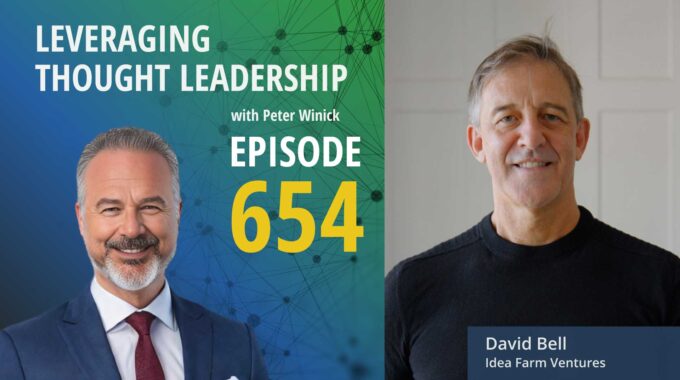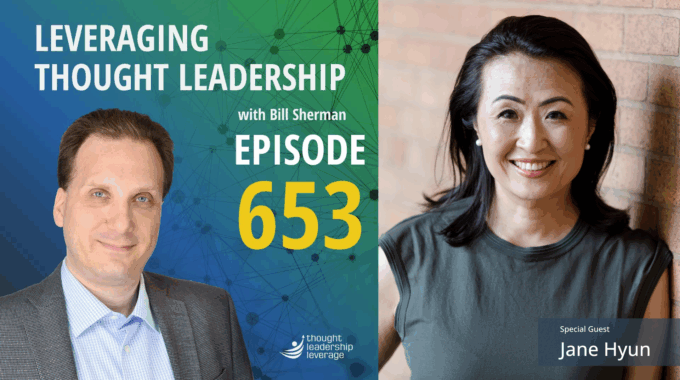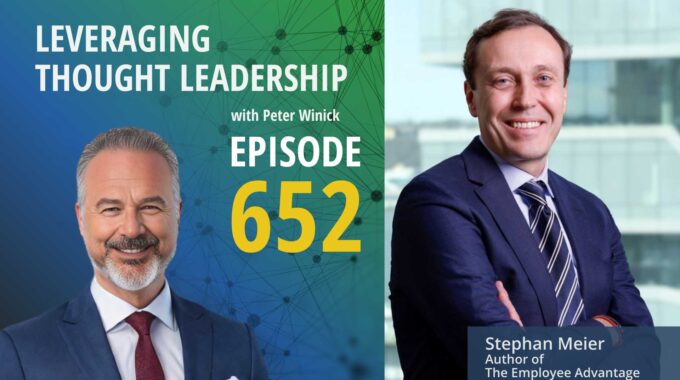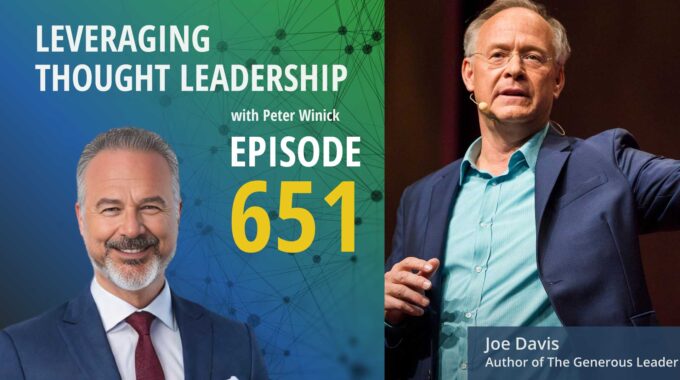Turning frameworks into funding: The hard truth about scaling thought leadership. This episode explores how…
Thought Leadership to Become Unbusy | Garland Vance
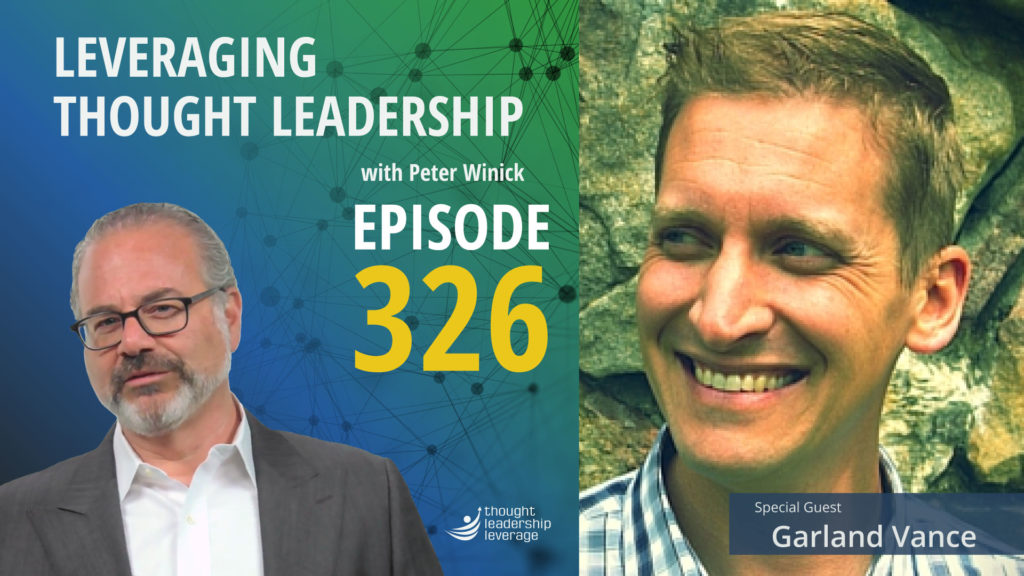
Thought Leadership for leading a life of purpose, productivity, and peace.
An interview with Garland Vance about helping leaders become less busy and more productive.
Is there a difference between activity and productivity? Both make you busy, but only one makes you fulfilled!.
Our guest on today’s episode is Garland Vance, the co-founder of Advance Leadership, a firm that helps leaders accomplish more and stress less. Garland is also the author of Getting’ (un)Busy, a book that takes you through the 5 steps to overcome “busyness” and live with purpose, productivity, and peace.
The conversation is an insightful and active one, with Garland sharing how his own “busyness” caused him significant health problems. This sparked his initial research, hoping to discover ways that he (and others) could accomplish more while doing less. He discovered ways to identify and focus on important tasks, and how a positive “ripple effect” could elevate everything else.
Garland’s business mode, delivering content through coaching and keynote speaking, was upended over the last year by COVID-19. Like many others, he needed to retool his content to reach a virtual audience. Always an innovator, Garland doesn’t simply talk for an hour and then disappear; he has found ways to make a 500-person Zoom call feel like a personal learning event, and he knows how to make each guest feel like the center of attention.
Garland also talks about the fact that “busyness” doesn’t qualify speed or skill. He assesses the 20 best practices of highly productive people, and why they aren’t overwhelmed with “busyness” – because they practice habits that make real differences! Combined with the 5 steps in his book, Gettin’ (un)Busy, he shares insights and ways you, too, can deconstruct bad habits and design the life you want to live!
Three Key Takeaways:
- Thought Leaders are easily overwhelmed with “busyness,” which can affect personal life and even health. Focus on the tasks that matter, and accept that you can’t do everything all at once.
- Productivity and activity are not the same thing. Garland’s thought leadership helps focus on productivity, and ways to fulfill life’s greater purposes.
- Taking a Thought Leadership keynote into a virtual presentation requires additional work, and there are simple ways to make the experience personal and create genuine connection with your audience.
If you need a strategy to bring your thought leadership to market, Thought Leadership Leverage can assist you! Contact us for more information. In addition, we can help you implement marketing, research, and sales. Let us help you so you can devote yourself to what you do best.
Transcript
Peter Winick And welcome, welcome, welcome, this is Peter Winick, I’m the founder and CEO of Thought Leadership Leverage, and you’re joining us on the podcast, which is Leveraging Thought Leadership today. My guest is Garland Vance. Garland is an author, a speaker and a consultant. He co-founded advanced leadership to help overwhelmed influencers and organizations live with purpose, productivity, and peace. He’s the author of Getting Busy, which Ford named as one of the seven books everyone on your team should read. He lives in Knoxville with his wife of 20 years, Dorothy, their three kids and a turtle. Learn more at events live and get in on busy books, so obviously we have to lead with the most interesting piece of your bio. So tell me about what it’s like to live with a turtle. I don’t think I’ve ever had a.
Garland Vance Very slow, very very slow. There is not a lot of action that goes on there.
Peter Winick Oh, there you go. So I guess with a wife and three kids, you get something in the house you could outrun. Is that?
Garland Vance Yeah, yeah. Some of our kids said, we need a pet and we were like, We need something that we really don’t have to take care of much. So a turtle, it is.
Peter Winick Wow. So that’s like a baby step above a cactus as it relates to pets.
Garland Vance We proposed the cactus, but the kids didn’t want that.
Peter Winick There you go. Anyway, back to our regularly scheduled program. So turtles are probably not super busy. So you know, you had an interesting mix in terms of, you know, in a previous life you were a pastor, you were in training development at Chick-Fil-A, speaker, author, consultant, etc. Sort of tie those all together for me. How the heck did you get here?
Garland Vance Yeah, so for me, it all started. I was in leadership, in high school, fell in love with leadership, ended up going to work with Chick-Fil-A on their nonprofit side. And literally on the first day of my job, they said, Hey, we want to take your division and redo everything and I was able to really shape from the ground up a leadership development program. And so that’s been the theme that’s run through my life. I did pastoral work, but I was a leadership development pastor, so I was there to help develop a leadership culture. And then as I started doing all of that, I just was spending more and more time with business leaders and realized leadership is leadership. It doesn’t matter if you’re in the nonprofit side, if you’re in the, you know, student development side, it doesn’t matter. Leadership is leadership and so just started working with business leaders and fell in love with that industry. And so that’s how I got into leadership development. And then the business section came around as I just in my own life, I was overwhelmingly busy to the point where my doctor was concerned for my life. And I started listening to other leaders and they were just saying over and over, we’re so busy, we’re so busy. And I said, nobody’s talking about this. And so I ended up doing my doctoral research on busyness and what it’s doing to leaders.
Peter Winick So, so let’s talk about the business piece because in some organizations, it’s cultural like, Oh, if you get in at 6:30 in the morning, I’ll get six and I’ll see your six and get you in at 5:30 or I’ll get into five 30, but I’ll be emailing at 3:00, right? So some of it is great. Some of it is a badge of honor. You know, in some organizations, and some of it is, is, I just think, a broken mindset, right? Because there’s activity and there’s productivity. And I think we live in a culture that rewards busy. Look. I can do three things at once. I can. I can drive, be on a Zoom call, and be doing my taxes on TurboTax on another device like that’s sort of the world that we’re living in, right? So as a contrarian perspective, although it’s backed up by a lot of research and mindfulness, and you’re not the sort of first one to go here, but what is unbiased, it doesn’t mean sitting there. Yes, I get like pondering your navel.
Garland Vance No, no. So I’ll tell you when I when I started researching busy-ness, for me, it was How do I help type A personalities who are incredibly driven, stay that way, stay incredibly driven while stressing less and doing less, but accomplishing more. And so I’m definitely not the first. “Un- busy-ness” for me, means that your life is filled with what I call purpose, productivity and peace. So purpose is, you know, your why you know why you’re on the planet. And the same is true in organizations. You know why your organization exists. Productivity is doing your why? And that’s where most organizations get it wrong. Like you said, they associate activity the number of hours we work with productivity and those two things are totally different. Productivity is all about doing your why. And great organizations know what their why is, and they do that really, really well. And they say no to a thousand other opportunities. And then the final is peace, which is resting in your why. Knowing that you can’t do everything individually or as a company, you can’t do everything. And so you rest in the fact of we’re doing our y really, really well. And I’ll tell you my time, we. Chick-Fil-A is one of the things that taught me there so well, because Chick-Fil-A has been so successful that they could be in a thousand other opportunities, and yet what they’re choosing, they have a small menu, they have small restaurants. I mean, everything is just laser-focused for them, so that they can know their why, do their why, and rest in their why.
Peter Winick So a couple of thoughts there. One is I think people have been thinking that driven and busy are synonyms and they’re not. You can be incredibly driven and not busy, and you can be incredibly busy and not driven. And I think many people operate as if they’re the same thing, right? And yeah, that’s interesting. So let’s go a little bit a different direction. So now you’ve got this brand of busyness speaking, advising, consulting, cetera. Talk about the business models underneath that, right? So how do you how do you help? Who do you help? What does that look like?
Garland Vance Sure, so a lot of what I do is around coaching, and so I’ll work with individual leaders or their teams a lot of times, and so they’ll come to me and they’ll say, we’re going through, you know, we have so many things we don’t exactly know how to get everything done. And what people are often coming to me for is how do we get more done? And I think they’re often asking the wrong question there. And it’s how do we get the right things done? How do we get the most important things done so that we get three or four things done and it has a ripple effect on everything else? So the business model is speaking pre-COVID. There was a lot more of that that was going on. Now it’s a lot of online presentation stuff and it’s
Peter Winick Stay there – really just, I want, I want to hang on that for a bit. So obviously pre-COVID, the speaking world was very different. You get on a plane, you go to Texas or Denver. Whatever rich, lather, repeat, do a good job. Do your thing right, make everybody happy, get paid well. Move on. There’s been this. Transition and we don’t we know it’s from something I’m not sure what it is to. But obviously there’s remote, there’s distance, et cetera, and a lot of speakers are struggling with, wait a minute, I’m doing the same thing, but I’m now being valued at 10 cents on the dollar or I can’t do the things that I did really well. Like when you think about what makes a great speaker great. It’s the stage presence. It’s being a little bit over the top. Not in a bad way, but you have to command the presence. Everybody’s the same size on Zoom, right? You can’t sort of be right, like when you do some of these, the things that are totally appropriate in front of five hundred on a Zoom call. It’s like, Whoa, I just turn the volume up on QVC. So how have you sort of transitioned the things that you were doing that would have been speaking in the physical world to other things? You still have the message and it’s still valuable and all that. But what does all that mean like today?
Garland Vance Yeah, so for me, I think the biggest transition has been the personalized side of the presentation, so when I do Zoom speaking, I don’t just sit back in a green room and then show up on the screen and present and then step off. I make an intentional effort to really engage relationally with people, so I’ll show up early. As long as the event will let me, I’ll show up five 10 minutes early and I’ll just be on the screen. I’ll say, Hey, as you as you’re coming in, tell me where you’re from and as they’re telling me where they’re from. I’ll comment on that or, oh, I’ve always wanted to go there. I love going there. And then throughout it, I’m asking questions.
Peter Winick So stay there for a moment, Garland. So in the speaking world, that would have been the equivalent of the speaker maybe sitting in the back of the room at the previous presentation for 20 minutes or being at the breakfast or something and walking, Hey, I’m Garland, I’m going to meet you later. Oh, what do you know? Similar, sort of warming up the crowd. So you have some friends, so you’ve you figured out where to attempt to do that in a digital world. I think that’s important because otherwise it’s this very Netflix kind of click-boom. You’re on, click-boom. You’re off. And it it sort of humanizes, or it’s hard to make that connection.
Garland Vance Yeah, and I think you can continue to do that throughout the presentation, and I think that’s where it becomes a lot of fun. So instead of me just having a 30 minute presentation and people, you know, given ovation at the end, I’m asking questions, I’m asking them to comment. You know, whether it’s, you know, if this is if you’ve ever said that you’re busy in the last week, right, busy in the comments and they were busy. And so all of a sudden, you’re interacting with them. So whereas before I could make eye contact with an individual for a few seconds and make them feel personalized. Now, when Shannon makes a comment online, I can say, Shannon, I really appreciate that comment. That’s really good insight. And so now all of a sudden, there’s it’s more of a smaller discussion. Or at least it feels like a smaller discussion, even if you’ve got 500 people on that call.
Peter Winick So you’re doing so basically that you’ve transitioned eye contact to chat because what was eye contact before it was the one to one acknowledgment, you know, and then then you might still have your back. You might make eye contact with four or five anchors. Right. And then every time you look, they smile. It sort of gives you a little energy. They feel like you’re talking to them, et cetera. So that’s interesting.
Peter Winick If you’re enjoying this episode of Leveraging Thought Leadership, please make sure to subscribe. If you’d like to help spread the word about our podcast, please leave us a review and share it with your friends. We’re available on Apple Podcasts and on all major listening apps, as well as at Thought Leadership Leverage dot com forward slash podcasts.
Peter Winick What about the you know, I’ve seen some others, and I’d love to get some best practices from you where it’s not just about the keynote anymore, it’s there’s some stuff I can do before. There’s some stuff I do during and there’s stuff I do after. So it is more of a learning event, not a transactional. You know, there are fifty-seven minutes we will be together.
Garland Vance Yeah. Yeah, and I think part of it depends on the event and how much freedom they give you. I know for me I have a business assessment and I’ll send participants ahead of time, often a Hey, if your you signed up for this workshop or you want to hear this, if you want to see how you stack up ahead of time versus the best practices, here’s an opportunity it’ll take you three minutes. Now, normally that could be something in a in a in a speech that I would send to them and send them to afterwards. But this is an opportunity to get them warmed up ahead of time and again. For me, I want to be part of my brand is truly I want to be a highly relational person. And so I’ll say, even in the midst of it follow up, I can always send them to kill busy dot com and get the free book. But a lot of times it’s this is my phone number. Hey, if you want to talk for I’ve got an hour that I’ve blocked out after this conversation, and if you want to talk, send me a text message and let’s get in contact with each other. It’s for me, it’s all about shrinking the feeling of that room. So it’s no longer I’m on a screen and there’s a talking head. It’s I’m in a conversation with a person, even if even if they’re on mute the whole time.
Peter Winick Got it. So what I love about what you’ve done is you’ve reinvented your experience, you’ve developed new capabilities in thinking about because the game of speaking was, I want to connect with each and everyone in that room, in that audience in a way that is relevant and powerful to them. And now, you know, we’re living in this virtual Peace Corps. What are the other underlying business models? You mentioned speaking, you mentioned coaching the assessment that you have. I think that’s interesting. That sounds like that’s a free tool. Is there a paid version to get a snapshot of, you know, because business is one of these subjective things you, you know, I might say I’m really busy and someone else might come and say, No, you’re not, you’re at your desk. Yeah, maybe — that’s not busy. Let me show you busy. So how do you assess, right?
Garland Vance Which is what happens all the time?
Peter Winick Yeah. Well, nothing. It becomes competitive, but speed is quantifiable. I’m driving 70 miles per hour. OK, then we can debate whether that was fast to you, or slow to you, but we have a basis. But how do you assess busyness? What do you what are the things that you’re looking for?
Garland Vance Yeah. So what I did is I compared the research. What we found is there were 20 best practices of highly productive but un-busy people. So, for example, highly productive, but un-busy people have a morning routine that starts with a sense of peace in their lives. They don’t get up and knock out their five most important productivity things that they need to do that day. What they do is they start their day with a sense of peace. And so we identified the 20 best practices of highly productive and busy people. And then the assessment scores you against or self-assesses you against those practices. So it gives you the opportunity to say, I do this, I don’t do this. You know, sometimes I do this, it’s on a four-point scale.
Peter Winick Done it. So you’re the comparison is against people that are doing things well, right? So it’s right, right?
Garland Vance And it gives you the opportunity. So the assessment is free. You can take it. You know, I encourage people, take it every three to six months and just see what kind of progress are you making on these 20 best practices? Because that’ll indicate that you’re moving toward and on busy lifestyle, which again, is highly productive but not overcommitted.
Peter Winick So let me push on that with you a little bit. So if you give busy people twenty things and say these are the metrics, many of them because they’re busy people, so I’m going to do all. 21 Great. Here’s the list alphabetically, as opposed to behaviorally, it would be wiser to say, let me pick one, maybe to focus on that for some period of time, two weeks a month, whatever. Yeah, I figure that one out to move to the next. So how do you coach people through that? Because you know, the yeah, the curse of the business is to do it all quickly, right?
Garland Vance So the way that the book is written and laid out is there’s actually five critical steps that a person has to go through to move from stressed, overwhelmed and exhausted to on busy. So you decide to get on busy, you deconstruct bad habits and inhibiting beliefs in your life. You design the life you want to live. You develop that in your calendar and your mindset, and then you draw other people in. So those 20 best practices are spread out over those five big steps that I’ll take people through. So a normal person. So it took me. Honestly, Peter took me three years. I was stressed, overwhelmed and exhausted, started doing the research, took me three years to figure out how to get on busy. And the only reason I did it is because I had a doctoral committee that was breathing down my neck. But what I ended up discovering was there’s a process that if you go through, you can do it in 30 days. So it went from three years for me to 30 days for four other people. And that’s how you learn to implement those little best practices at a time. And most of those best practices aren’t massively time consuming. It’s just re tweaking the way that you live just a little bit.
Peter Winick Yeah. So it sounds like sort of more classic habit development. Right? So getting out of bad habits and replacing them with better pieces, because what you described earlier with sort of people that are highly productive is almost ritualistic, right? They get up and this is what they do and then compare that you get up and grab your phone and check the, you know, it was a book years ago, but you don’t check email in the morning. Right, right. So what is it that you do and you immediately get into busy work quickly, because that probably sets the tone for the day, right?
Garland Vance Yeah, absolutely, absolutely. The way you start your day is the way you continue your day.
Peter Winick Well, this has been great. So let me just as we start to wrap up here, what’s next? What do you see around the bend? And I don’t mean, you know, necessarily COVID, but sort of what is the net? What’s the next chapter for you if we were to retouch in a year or two? What do you think?
Garland Vance Yeah. So I’m excited about the next chapter where my wife and I are actually co-writing our next book together. So she’s been in leadership development for 20 years. She just wasn’t passionate about getting on busy. You know, her life wasn’t on the line, but.
Peter Winick She’s raising a turtle, so give her some slack.
Garland Vance Right, right. It’s a lot of work, a lot of work. No, so that we are working on our next book is called Unleashed Leadership. And so it’s been over the last 20 years of coaching and consulting. We’ve identified seven issues that probably create about 95 percent of the problems that our clients have faced over the years. And so we’ve said if we can identify those seven issues and the best practices around those seven issues. So I’m super excited about that. We’ve designed everything. We’re actually leading groups through it already. And so that’s slated to be released next Q1 of next year.
Peter Winick Excellent. Well, this has been great. I appreciate your time and sharing, sharing your journey with us and thank you so much. Thanks, Garland.
Garland Vance Thanks, Peter.
Peter Winick To learn more about Thought Leadership Leverage, please visit our web site at ThoughtLeadershipLeverage.com to reach me directly. Feel free to email me at Peter at ThoughtLeadershipLeverage.com and please subscribe to Leveraging Thought Leadership on iTunes or your favorite podcast app to get your weekly episode automatically.



